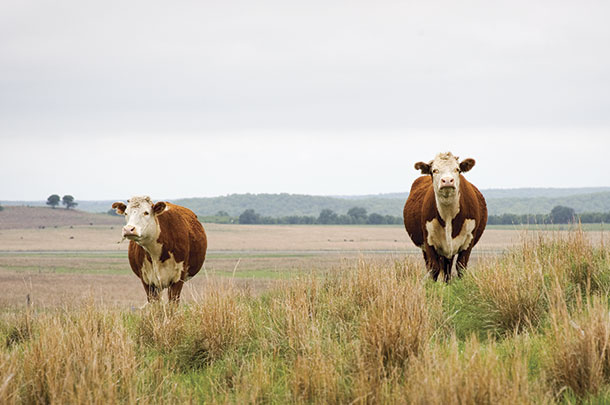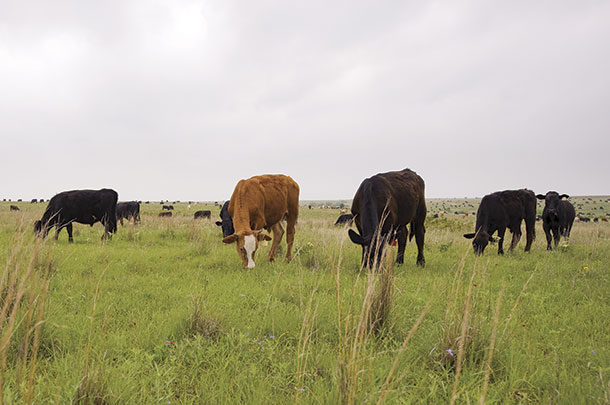Often, in the course of our work as consultants in the Southern Great Plains, we work with clients through land management issues that have a relatively straightforward answer. For the most part, we address a producer’s concerns based on a particular land management goal.
For instance, if a producer wants to increase forage production on his or her operation, there are several ways to meet that goal.
Many times, ecological barriers of production are the easiest to address. Other times, it is perceptual misconceptions that affect an operation the most. Sometimes those misconceptions are driven by years of operational inflexibility or by the unwillingness to manage adaptively.
Regardless of the reason, there are many common grazing management misconceptions that result in facing a rather steep and abrupt learning curve. The following outlines 10 common grazing management misconceptions.
1. ‘In this county, I can run a cow per 10 acres.’
Stocking rate is the single-most important decision a producer makes. Stocking rates are calculated by balancing animal demand with forage supply. Often, we hear of instances where producers are managing under a county-based stocking rate.
Stocking rates are operation-specific and are influenced by grazing history, forage type, climate, land capability, livestock type and class, etc. County-based stocking rates tend to overstock some operations and understock others. In my experience, the majority tend to overstock.
It is also a frequent misconception that implementing a grazing system will alleviate stocking rate problems. Over the long term, no grazing system will work if the stocking rate is not balanced with the annual forage produced.
2. ‘My cows graze all of my ranch.’
The actual number of grazable acres of an operation is very often overlooked. It is very rare that every acre of the pasture is usable by livestock. Often, even if the producer went through the process to develop a balanced stocking rate, if he or she did not compensate for the grazable acres of the management unit, they will be overstocked from day one.
There are many factors that lead to actual grazable acres being limited. Slope is a common limiter. Most cattle do not want to graze on slopes steeper than 30 percent. Acres of heavy brush are also a common limiter since those acres, even if accessible by cattle, do not produce the same amount of forage as open areas.
Many producers also overlook acres of surface water. Another common limiter is ranch roads. For instance, 1 mile of 20-foot-wide ranch road equals 2.4 acres. If we add up the distance of all the access and ranch roads, the total is sometimes surprising. An accurate stocking rate is one that has compensated for the acres on an operating unit which cannot be grazed.
3.‘Grazing hard in the winter won’t hurt my grass.’
The forage base of the Southern Great Plains is primarily warm-season-dominated, which means most forage production occurs in the summer growing season the majority of years. It is common to stockpile native rangeland for winter grazing.
It is also a common misconception that native plants can be heavily grazed in the winter as long as they are not growing.
Most of our native warm-season perennial grasses begin to develop next year’s young shoots in the fall of the previous year. These young shoots are called phytomers and need protection through the winter. This is one reason for leaving an appropriate stubble height on native grasses.
This stubble provides some thermal protection but mostly ensures it is not grazed. Excessive grazing pressure in the fall/winter on native perennial grasses can reduce next spring’s number of shoots/plants and reduce overall annual production in the spring.
4. ‘I rested this pasture all winter.’
Many times, our good intentions can work against us. Resting pastures, or providing a specified time without grazing, allows plants to recover from the grazing event. Typically, we plan to allow our primary forage species time to fully recover before a second grazing period.
The trouble with resting all winter is: This is not active growing season rest. Perennial plants need periodic rest periods during the active growing season in order to rebuild carbohydrates reserves. Rest during the dormant season does not achieve this function.
5. ‘But I only grazed half of it.’
Most perennial forage species have a specific percentage grazing utilization they can tolerate before they are forced to utilize carbohydrate reserves to replenish. For native warm-season grasses, that utilization rate is typically 50 percent; some introduced species can tolerate much higher rates. Another way to look at it is: Grasses are quite efficient; they produce close to twice what they need to sustain themselves.
Thus, if we graze half of that production, the plant still has the capability to fully recover and thrive. However, of the half we utilize, 25 percent is lost to trampling, environmental losses, other grazing, etc. In essence, on rangeland, only the remaining 25 percent of the total annual production of the pasture should be used to determine the stocking rate.
Consequently, the “take half, leave half” concept is commonly misunderstood, and pastures end up overgrazed.
 Photo courtesy of USDA Natural Resources Conservation Service.
Photo courtesy of USDA Natural Resources Conservation Service.6. ‘If I leave it, I’m wasting grass.’
Residual stubble is often considered wasted if it is not consumed. Grasses need residual stubble for multiple reasons. Residual stubble serves as armor for the soil. Keeping the soil covered and limiting bare ground should be a primary goal of grazing management plans.
Residual cover keeps the soil temperature regulated, cooler in the summer primarily. High soil temperatures can limit soil biological function and organic matter cycling. Another key attribute of residual cover is slowing down runoff, therefore reducing erosion. Residual forage also aids in weed control by limiting weeds’ competitive advantage. Normally, the less bare ground, the less weed pressure.
7. ‘Stock density doesn’t matter.’
Stock density is the number of animals on a specific area for a specific amount of time. This is typically expressed as pounds of live weight per acre. Stocking rate for the whole ranch is very important. However, stock density is a management tool that can allow you to make vast ecological improvements on your property if properly applied. The higher the stock density, the more concentrated the livestock on a smaller area.
This allows for more even manure and urine distribution, more effective grazing distribution and more efficient forage utilization. The converse is also true: Very light stock density can lead to spot grazing, under-utilized forage and slower recovery. Stock density very much matters.
8. ‘Grass is grass; what’s the difference?’
Not all grasses are created equal. Native or introduced, annual or perennial, no two species of grass are the same. Grasses differ physiologically in the way they grow just as much as the amount they can grow. Production capability is a function of the plant’s intrinsic traits, but it also depends on climate, fertility and soil capabilities. Almost equally as diverse is their forage quality capabilities and limitations.
9. ‘If I can run one more cow, that’s more profit.’
One more cow does not always equal one more dollar of profit, but it does ensure more input costs. It can be profitable if a property is under-utilized, but the reality is: Most properties are at least grazed moderately heavy. One more cow may be that tipping point at which costs exceed revenue. Again, proper stocking rate is often the determinant of economic success.
10. ‘I’ll just feed my way through this drought.’
The most successful grazing managers are flexible and adaptive. Adaptive management necessitates flexible stocking rates. Many times, the decision to reduce stocking rate is the hardest to discuss and accept. To ease that problem, a drought contingency plan with active management triggers can alleviate some of that anxiety. You will at least know what to watch for, how to mitigate its effects and how to react in a timely manner.
Feeding through the drought is not only dependent upon the cost of forage resources and the value of weaned beef, but the cost incurred by your forage resource and its ability to repay the bill. Feeding your way through the drought can have costly economic and ecologic ramifications.
Grazing management is a complex part of managing a ranch. Not only are producers trying to manage an ecological system and an animal production cycle that is constantly changing, they are trying to grow their products in fluctuating markets and make a living. Limiting grazing misconceptions can increase your chance of ecologic and economic success.
— Article submitted by Noble Research Institute LLC








